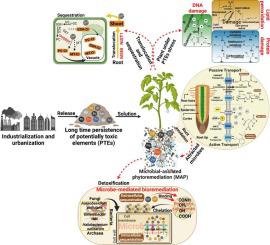当前位置:
X-MOL 学术
›
Earth Sci. Rev.
›
论文详情
Our official English website, www.x-mol.net, welcomes your
feedback! (Note: you will need to create a separate account there.)
Microbe-assisted phytoremediation of toxic elements in soils: Present knowledge and future prospects
Earth-Science Reviews ( IF 10.8 ) Pub Date : 2024-06-28 , DOI: 10.1016/j.earscirev.2024.104854 Guo Yu , Habib Ullah , Balal Yousaf , Krzysztof Pikoń , Vasileios Antoniadis , Majeti Narasimha Vara Prasad , Nanthi Bolan , Jörg Rinklebe , Rao Zepeng , Sabry M. Shaheen , Liheng Liu
Earth-Science Reviews ( IF 10.8 ) Pub Date : 2024-06-28 , DOI: 10.1016/j.earscirev.2024.104854 Guo Yu , Habib Ullah , Balal Yousaf , Krzysztof Pikoń , Vasileios Antoniadis , Majeti Narasimha Vara Prasad , Nanthi Bolan , Jörg Rinklebe , Rao Zepeng , Sabry M. Shaheen , Liheng Liu

|
In the face of escalating anthropogenic impacts stemming from urbanization and industrialization, our study delves into the critical realm of potentially toxic elements (PTEs) contamination in soil, unraveling a complex web of interactions that imperil soil environments and their vital microbial and enzymatic activities. Unlike organic pollutants, PTEs resist microbial degradation and their presence disrupts soil microbial and enzymatic activities, affecting the nutrient cycle and plant growth. There is a need to find effective nature-based solutions for addressing soil contamination with PTEs; this quest has led to increased interest in bioremediation, utilizing bacteria, fungi, algae, and plants for sustainable environmental cleanup. While previous reviews have addressed general principles about the bioremediation of PTEs contaminated soils, there are no critical reviews which have been published about the current state of the microbe-assisted phytoremediation (MAP). Particularly, this review aims at meticulously examining the understudied roles of diverse microbes-archaea, bacteria, and fungi in the rhizosphere of hyperaccumulators under PTEs stress. In doing so, it also expands our understanding of the plant root microbiome's contribution to phytoremediation of PTEs in hyperaccumulator plants. We focus on how PTE pollution influences plant signaling pathways, root exudate profiles, and subsequent interactions with diverse microbial communities. Also, we discuss the behavior of archaea towards MAP, filling a significant gap in current understanding. Moreover, we comprehensively analyze how microbial communities interact with hyperaccumulators, and discuss the most recent research that expands beyond the known role of organic acid producers to explore how a wider range of diverse phytobiome collaborates with plants to detoxify PTEs, influencing biogeochemical cycles in intriguing ways. This review examines the biochemical and molecular mechanisms that promote plant growth, offering a comprehensive perspective on the present knowledge and future prospects in this field. By synthesizing existing knowledge, this review provides insights into effective strategies for remediating PTEs-polluted soils. The findings are relevant for researchers, environmental scientists, and policymakers, guiding future efforts to address the growing issue of PTEs contamination and its impact on soil ecosystems.
中文翻译:

土壤中有毒元素的微生物辅助植物修复:现有知识和未来前景
面对城市化和工业化带来的不断升级的人为影响,我们的研究深入研究了土壤中潜在有毒元素(PTE)污染的关键领域,揭示了危害土壤环境及其重要微生物和酶活性的复杂相互作用网络。与有机污染物不同,PTE 可以抵抗微生物降解,它们的存在会破坏土壤微生物和酶活性,影响养分循环和植物生长。需要找到有效的基于自然的解决方案来解决 PTE 造成的土壤污染;这一探索导致人们对生物修复、利用细菌、真菌、藻类和植物进行可持续环境清理的兴趣日益浓厚。虽然之前的评论已经讨论了 PTE 污染土壤生物修复的一般原则,但尚未发表关于微生物辅助植物修复 (MAP) 现状的批判性评论。特别是,这篇综述旨在仔细研究 PTE 胁迫下超积累植物根际中不同微生物(古细菌、细菌和真菌)的作用。在此过程中,它还扩大了我们对植物根部微生物组对超积累植物中 PTE 的植物修复的贡献的理解。我们关注 PTE 污染如何影响植物信号通路、根系分泌物特征以及随后与不同微生物群落的相互作用。此外,我们还讨论了古细菌对 MAP 的行为,填补了当前理解的重大空白。 此外,我们全面分析了微生物群落如何与超富集植物相互作用,并讨论了最新的研究,这些研究超出了有机酸生产者的已知作用,探索更广泛的多样化植物生物组如何与植物合作解毒 PTE,以有趣的方式影响生物地球化学循环。这篇综述研究了促进植物生长的生化和分子机制,为该领域的现有知识和未来前景提供了全面的视角。通过综合现有知识,本综述提供了修复 PTE 污染土壤的有效策略的见解。这些发现与研究人员、环境科学家和政策制定者相关,指导未来解决日益严重的 PTE 污染问题及其对土壤生态系统的影响。
更新日期:2024-06-28
中文翻译:

土壤中有毒元素的微生物辅助植物修复:现有知识和未来前景
面对城市化和工业化带来的不断升级的人为影响,我们的研究深入研究了土壤中潜在有毒元素(PTE)污染的关键领域,揭示了危害土壤环境及其重要微生物和酶活性的复杂相互作用网络。与有机污染物不同,PTE 可以抵抗微生物降解,它们的存在会破坏土壤微生物和酶活性,影响养分循环和植物生长。需要找到有效的基于自然的解决方案来解决 PTE 造成的土壤污染;这一探索导致人们对生物修复、利用细菌、真菌、藻类和植物进行可持续环境清理的兴趣日益浓厚。虽然之前的评论已经讨论了 PTE 污染土壤生物修复的一般原则,但尚未发表关于微生物辅助植物修复 (MAP) 现状的批判性评论。特别是,这篇综述旨在仔细研究 PTE 胁迫下超积累植物根际中不同微生物(古细菌、细菌和真菌)的作用。在此过程中,它还扩大了我们对植物根部微生物组对超积累植物中 PTE 的植物修复的贡献的理解。我们关注 PTE 污染如何影响植物信号通路、根系分泌物特征以及随后与不同微生物群落的相互作用。此外,我们还讨论了古细菌对 MAP 的行为,填补了当前理解的重大空白。 此外,我们全面分析了微生物群落如何与超富集植物相互作用,并讨论了最新的研究,这些研究超出了有机酸生产者的已知作用,探索更广泛的多样化植物生物组如何与植物合作解毒 PTE,以有趣的方式影响生物地球化学循环。这篇综述研究了促进植物生长的生化和分子机制,为该领域的现有知识和未来前景提供了全面的视角。通过综合现有知识,本综述提供了修复 PTE 污染土壤的有效策略的见解。这些发现与研究人员、环境科学家和政策制定者相关,指导未来解决日益严重的 PTE 污染问题及其对土壤生态系统的影响。































 京公网安备 11010802027423号
京公网安备 11010802027423号